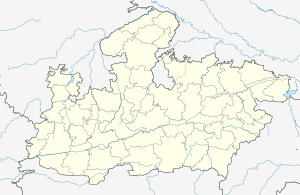Deogarh, Madhya Pradesh
Deogarh, also known as Devgarh, is a village in Chhindwara District of the Indian state of Madhya Pradesh. It is located 24 miles southwest of Chhindwara, picturesquely situated on a crest of the hills.
Deogarh | |
|---|---|
city | |
 Deogarh Location in Madhya Pradesh, India  Deogarh Deogarh (India) | |
| Coordinates: 21°52′57.36″N 78°43′58.69″E | |
| Country | |
| State | Madhya Pradesh |
| District | Chhindwara |
| Languages | |
| • Official | Hindi |
| Time zone | UTC+5:30 (IST) |
| ISO 3166 code | IN-MP |
| Vehicle registration | MP-28 |
Deogharh was formerly the capital of a Gond kingdom, which rose to prominence in the late 17th and early 18th centuries. The numerous wells, tanks, and buildings show that the Gond capital once extended over a large area.
History

Popular tradition tells of a Gaoli Kingdom preceding the Gonds. The mythical Gond hero Jatba, who founded the dynasty, was born from a virgin under a bean plant, and was protected by a cobra, who came and spread its hood over him during the heat of the day, when his mother left him to go to her work. When he grew up he became famous for his feats of strength, and entered the service of the twin Gaoli kings, Ransur and Ghansur, whom he subsequently slew with a magic sword, and taking the kingdom in their stead became the first Gond ruler. The forts of Patansaongi and Nagardhan in Nagpur District are attributed to him.
The Devgarh a Gond raja reigned till A.D 1035, and was succeeded by a Bhil king who ruled up to (A.D. 1085), being a period of fifty years.[1]
In the late 17th century, Prince Bakht Buland went to Delhi, where he entered the service of the Mughal emperor Aurangzeb. He gained the emperor's favor by his military achievements, and the emperor persuaded him to become a Muslim. He returned from Delhi with a number of craftsmen and farmers, both Hindu and Muslim. He enlarged his dominions at the expense of the states of Chanda and Mandla, and established many new towns and villages, including the city of Nagpur.
Bahkt Buland's successor, Chand Sultan, moved the capital of the kingdom from Deogarh to Nagpur. After Chand Sultan's death in 1739, struggles over his succession led to the intervention of the Maratha leader Raghoji Bhonsle, who governed neighboring Berar in the name of the Peshwa of the Maratha Empire. The Gond kingdom was annexed to the Maratha empire, and ruled by Raghoji's successors.
The Bhonsle kingdom was defeated the British in the Anglo-Maratha Wars, and became a princely state of British India. The Nagpur kingdom was annexed by the British in 1853 under the Doctrine of lapse, and was governed as Nagpur Province until 1861, when it became part of the Central Provinces. After India's independence in 1947, the Central Provinces became the new state of Madhya Pradesh.
References
| Wikimedia Commons has media related to Deogarh Fort, Chhindwara. |
- Hunter, William Wilson, Sir, et al. (1908). Imperial Gazetteer of India, Volume 10. 1908–1931; Clarendon Press, Oxford.